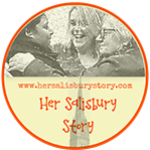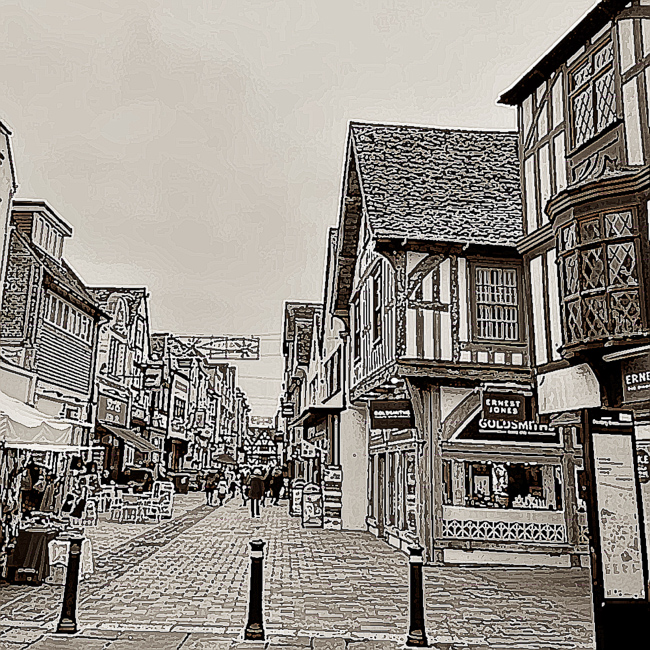This is not just the story of one Salisbury woman, but rather the story of how women were integral to the small family businesses that were the mainstay of the city’s economy in the nineteenth century, with each generation of women providing role models for the next. Maria Meatyard (1807-1894) was 21 when she married Simon Smith in 1828.1 The Smith family were butchers trading from 23-25 Butcher Row for over sixty years. The Meatyards were also butchers, trading from 27 Castle Street, at the entrance to the Free Grammar School, for over a hundred years.
Parents
When Maria was 30, her father-in-law died and her mother-in-law Sarah Smith took over the Butcher Row business, guiding it for the next 28 years.2 Sarah initially advertised the business in her own name, but then traded as Simon Smith or as Smith & Son.3 However Sarah was clearly the driving force since a later census listed Sarah as butcher and Simon, aged 41, as butcher’s son and assistant.4 When Maria was 50, Simon died.5 Maria took over Simon’s share in the partnership and the business was then advertised as Sarah & Maria Smith for nine years, until just before Sarah’s death at the age of 76.6
Maria’s father had died the year before Simon’s father.7 Her mother Lydia Meatyard took over the Castle Street business and ran it with the help of two of her sons. John ran the main shop while Thomas, the older son, ran a branch on the other side of the road.8 The business was advertised under Lydia’s name and then under Thomas’s, but Lydia retained control of the business under the terms of her husband’s will.9 She ran it for nine years until her death.10
Sisters-in-law
Thomas and John jointly inherited the business after their mother’s death. They ran it first as a partnership and then as rival businesses on opposite sides of Castle Street until Thomas went bankrupt.11 After John died, his widow Sophia took over the business.12 Maria supported Sophia by offering the help of her most experienced butcher, who then stayed on working for Sophia for 19 years.13
So the two businesses that had been run by Sarah and Lydia were now being run by Maria and her sister-in-law Sophia in the next generation. Maria had already been running the business for nine years with Sarah and now advertised it as Maria Smith & Son, with her son James in partnership. Four years later Maria retired, aged 63, to No 1 Garden Villa, Bemerton leaving James in charge.14 She died at the age of 87, living back in Castle Street, possibly being looked after by Sophia’s daughter-in-law Amelia towards the end of her life.15
When Sophia was widowed she had four children under the age of six.16 She raised her family and also ran the Meatyard’s shop in Castle Street for 19 years, latterly with the help of her son William.17 Sophia died at the age of 58, two years after Maria retired.18
Children
These two businesses were then run by the next generation, Maria’s son James and her nephew William. James Smith ran the Butcher Row shop for 16 years and then his widow Hester continued for another seven years with the help of son Joseph before retiring.19 William Meatyard ran the Castle Street shop for 12 years before leaving a widow, Amelia, with four children under the age of eight.20 Amelia raised her family and also ran the business for a further 21 years, latterly with the help of her son William.21
Grandchildren
Moving on to the next generation, Joseph took over the Butcher Row shop in 1894.22 His widowed mother-in-law Charlotte Rowe came to live with them and she started learning the butcher’s trade at the age of 55.23 By 1907 he had sold up and become a farmer in East Wellow.24 William took over the Castle Street shop in 1906 and was there in 1911.25 By 1915 he had sold up and moved to Crane Street, living off the income from his property.26
The story of this family business is reflective of a pattern of activity that was repeated across the city by women in all trades, providing livelihoods for families through the generations.27
Written and researched by Brian Evans. Edits by S.Ali.
Notes
1 St Thomas’s parish records, 1828. His father James had to give parental consent as Simon was under the age of 21.
2 St Thomas’s parish records, 1838.
3 Sarah Smith took Simon into partnership after three years.
[Salisbury & Winchester Journal, 8 November 1841]
4 1851 census TNA HO 107/1847/77.
5 The business was then run by Sarah and Maria, with grandson James as manager.
[Salisbury & Winchester Journal, 2 January 1858; St Thomas’s parish records, 1857]
6 Sarah Smith retired and formally passed her share of the business to her grandson four months before she died.
[Salisbury & Winchester Journal, 10 March 1866; St Thomas’s parish records, 1866]
7 St Edmund’s parish records, 1837.
8 In 1841 Lydia and John were living at 27 Castle Street, Thomas was living on the other side at 30 Castle Street.
[1841 census TNA HO 107/1190/6 and TNA HO 107/1190/1]
9 James’s will gave Lydia a life interest in his properties, household goods and all his equipment, stock & debtors of the butcher’s trade. Thomas and John then inherited all of Lydia’s life interest.
[Prerogative Court of Canterbury Wills, 1837]
10 St Edmund’s parish records, 1844.
11 The partnership between Thomas and John was dissolved after two years.
[Salisbury & Winchester Journal, 24 October 1846]
12 Sophia had run the business for six months after John’s death before putting a notice in the paper. It was the same edition that carried the notice of Thomas’s bankruptcy, so she probably issued it to make clear that hers was a separate business.
[Salisbury and Winchester Journal, 9 June 1855; St Edmund’s parish records, 1854]
13 John Randall worked for Sarah, initially as an apprentice, and lived above the shop in Butcher Row for 17 years. He then worked for Sophia and lived above the shop in Castle Street for 19 years, before marrying and setting up in Salt Lane.
[1881 Census TNA RG 11/2072/10]
14 Salisbury & Winchester Journal, 10 September 1870; 1871 Census TNA RG 10/1957/19.
15 Maria was living in Castle Street when she died. By then Amelia was running the Meatyard’s shop
[1891 Census TNA RG 12/1620/3; St Edmund’s parish records, 1894]
16 1861 census TNA RG 9/1316/4; St Thomas’s parish records, 1848-1854
17 Sophia took William into formal partnership a week before she died.
[Salisbury & Winchester Journal, 29 March 1873]
18 St Edmund’s parish records, 1873.
19 St Thomas’s parish records, 1887; Salisbury & Winchester Journal, 14 July 1894.
20 St Thomas’s parish records, 1885; 1891 Census TNA RG 12/1620/3
21 Amelia took William into formal partnership a year before she died.
[Salisbury & Winchester Journal, 11 February 1905; England & Wales Civil Registration Death Index 1906]
22 The business must have been founded after 1808 when Simon was born in London. It was first listed in 1830, so at least 64 years previously. However it could be a lot older. The 1822 classified directory omitted the classification of butchers!
23 Charlotte’s husband had a variety of jobs in Salisbury. She may have helped him in business, but always left her occupation in the census blank. However at the age of 65 she described herself as a retired butcher.
[Census 1861 TNA RG 9/1316/105; 1871 TNA RG 10/1956/31; 1881 TNA RG 11/2070/45; 1891 TNA RG 12/12/14; 1901 TNA RG 13/1951/131]
24 Joseph was a farmer at Black Hill Farm, with his wife assisting and his daughter rearing poultry.
[Census 1911 TNA RG 78/279]
25 The business must have been founded by 1804, the first baptism record for James & Lydia in St Thomas’s parish rather than St Edmund’s, so at least 107 years previously.
26 He is listed at 84 Crane Street with occupation “appartments”.
27 Another snapshot of women in business is to look at the sisters-in-law’s siblings. Maria had three sisters and three brothers including John.
At that time, the law was that a wife’s assets belonged to her husband. However there were ways of giving a married woman some independence. Mary, who had married a carpenter from Fonthill Bishop, was bequeathed in her father’s will five shillings a week for life “into the hands of her my said daughter alone, notwithstanding of her said husband, and her script alone, not withstanding her present or any future husband, shall be a good discharge.”
[Prerogative Court of Canterbury Wills, 1837]
Elizabeth married a grocer in Silver Street and ran the business from the age of 60, when she was widowed, for at least ten years before selling up and retiring on an annuity.
[Census 1871 TNA RG 10/1953/55; 1881 TNA RG 11/2072/5]
Harriot married a grocer in Winchester Street who died when she was 30. She moved to St Edmund Church Street and worked as a straw bonnet maker to support her young family until her death 12 years later.
[Census 1841 TNA HO 107/1190/3; 1851 TNA HO 107/1847/133]
James was a butcher in Wilton. After his death his wife Ann sold up and later described herself as a retired butcher rather than a butcher’s widow.
[Census 1861 TNA RG 9/1316/78]
After Thomas became bankrupt he moved to Pain’s Hill, seeking work as a journeyman butcher. After he died his wife Ann lived on for 13 years, describing herself as a needlewoman. This was sometimes a way for a family to support elderly relatives by disguising charity as payment for work.
[Census 1871 TNA RG 10/1956/65]
Sophia had one sister and three brothers. Elizabeth helped their mother run The Wheel Inn at Shrewton while their father was a farmer. Edward farmed at Amesbury while his wife Mary Ann ran The George Inn and posting house. John was unmarried, a grocer in Shrewton. Alfred was a master brewer in Bath, whose wife Caroline was left well provided for after his death.
[Census 1841 TNA HO 107/1167/12; 1851 TNA HO 107/1845/40; 1851 TNA HO 107/1845/154; 1881 TNA RG 11/2442/6]
Bibliography
Trade Directories
W Holden 1805
J Pigot/Slater’s 1822, 1830, 1842, 1844, 1852
Robson’s 1839
Post Office/Kelly’s 1849, 1855, 1859, 1867, 1875
Hunt & Co 1851
Harrod’s 1865
Kelly’s 1889, 1895, 1898, 1903, 1907, 1911, 1915
Others
Ancestry, Subscription service, https://www.ancestry.co.uk
British Newspaper archive, Subscription service, https://www.britishnewspaperarchive.co.uk
Chandler, John, 1983, Endless Street, a history of Salisbury and its people, Hobnob Press
Crittal, Elizabeth, 1959, A History of the County of Wiltshire, Volume 4. Agriculture & Industry,
Victoria County History, https://www.british-history.ac.uk/vch/wilts/vol4
Crittal, Elizabeth, 1962, A History of the County of Wiltshire, Volume 6. Old and New Salisbury,
Victoria County History, https://www.british-history.ac.uk/vch/wilts/vol6
Haskins, Charles, 1912, The Ancient Trade Guilds and Companies of Salisbury, Bennett Brothers
https://archive.org/details/ancienttradeguil00hask/page/n3
Leicester University special collections online, Historical Directories of England & Wales,
http://specialcollections.le.ac.uk/digital/collection/p16445coll4, accessed June 2021
National Library of Scotland, England & Wales OS 1:500 town plan Salisbury LXVI 15.4; 1880
https://maps.nls.uk/towns/salisbury.html
Rogers, K H, 1991, Early trade directories of Wiltshire, Wiltshire Record Society Vol 47
http://www.wiltshirerecordsociety.org.uk/pdfs/wrs_v47.pdf
Royal Commission for Historic Monuments in England, 1977, Ancient and Historical Monuments
in the City of Salisbury, The Royal Commission for Historic Monuments in England,

